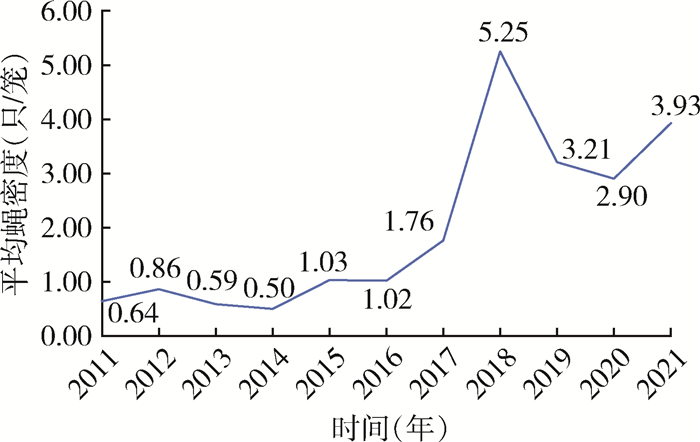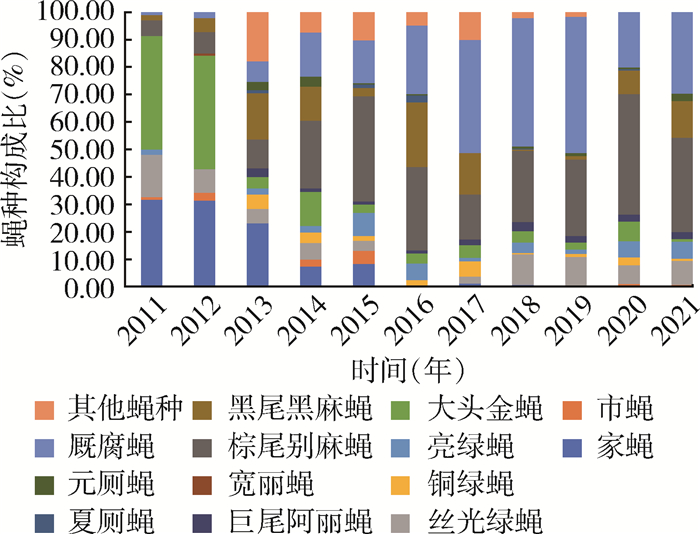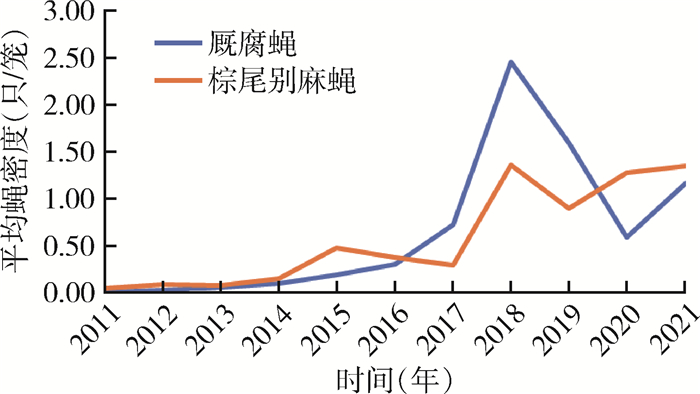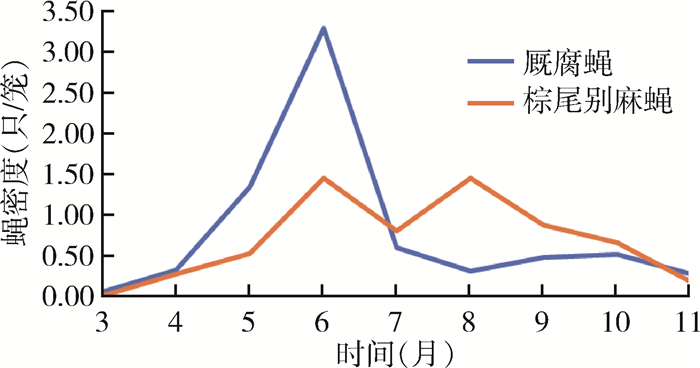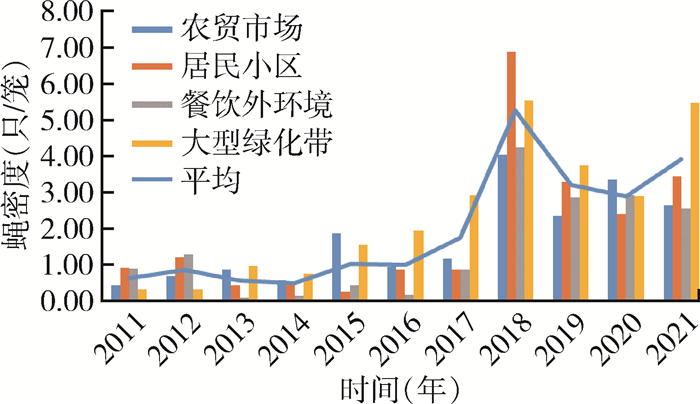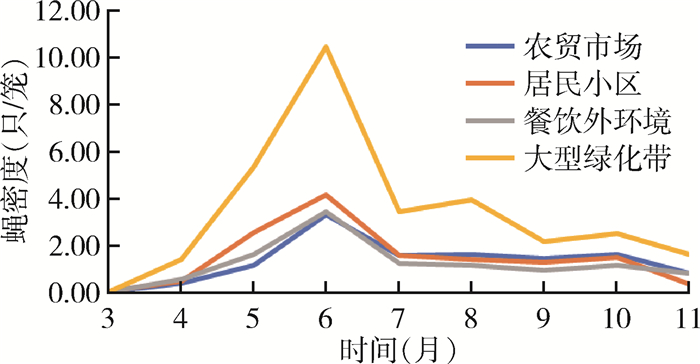| 1 |
赵爱华. 泰安市城区2007-2010年蝇密度及季节消长情况分析[J]. 中国媒介生物学及控制杂志, 2012, 23 (2):160-161.
|
|
Zhao AH. Seasonal fluctuations in the density of flies in the urban area of Tai'an city from 2007 to 2010[J]. Chin J Vector Biol Control, 2012, 23 (2):160-161.
|
| 2 |
陶卉英, 柳小青, 马红梅, 等. 南昌市重点行业蝇类危害风险评估[J]. 中国媒介生物学及控制杂志, 2015, 26 (5):491-494.
DOI
|
|
Tao HY, Liu XQ, Ma HM, et al. Risk assessment and control of flies in major industries of Nanchang city[J]. Chin J Vector Biol Control, 2015, 26 (5):491-494.
DOI
|
| 3 |
马卓, 魏绪强, 阙燃, 等. 北京市东城区2014-2019年蝇密度监测及季节消长分析[J]. 中国媒介生物学及控制杂志, 2020, 31 (6):690-694.
DOI
|
|
Ma Z, Wei XQ, Que R, et al. Surveillance and analysis of fly density and seasonal fluctuation in Dongcheng district of Beijing, China, 2014-2019[J]. Chin J Vector Biol Control, 2020, 31 (6):690-694.
DOI
|
| 4 |
于雪岚, 刘鹃, 刘鹏. 2017-2019年内江市蝇密度监测及季节消长分析[J]. 中华卫生杀虫药械, 2021, 27 (2):136-138.
DOI
|
|
Yu XL, Liu J, Liu P. Monitoring and seasonal fluctuation of flies in Neijiang from 2017 to 2019[J]. Chin J Hyg Insect Equip, 2021, 27 (2):136-138.
DOI
|
| 5 |
王雪霜, 吴海霞, 岳玉娟, 等. 2018年全国蝇类监测报告[J]. 中国媒介生物学及控制杂志, 2019, 30 (2):139-141, 150.
DOI
|
|
Wang XS, Wu HX, Yue YJ, et al. National vectors surveillance report on flies in China, 2018[J]. Chin J Vector Biol Control, 2019, 30 (2):139-141, 150.
DOI
|
| 6 |
王雪霜, 吴海霞, 刘起勇. 2019年全国蝇类监测报告[J]. 中国媒介生物学及控制杂志, 2020, 31 (4):407-411.
DOI
|
|
Wang XS, Wu HX, Liu QY. National surveillance report on flies in China, 2019[J]. Chin J Vector Biol Control, 2020, 31 (4):407-411.
DOI
|
| 7 |
杨迎宇, 朱江, 孙春卫. 2012-2015年上海市宝山区蝇类监测分析[J]. 中华卫生杀虫药械, 2020, 26 (2):145-147.
DOI
|
|
Yang YY, Zhu J, Sun CW. An investigation on flies in Baoshan district of Shanghai from 2012 to 2015[J]. Chin J Hyg Insect Equip, 2020, 26 (2):145-147.
DOI
|
| 8 |
凌超. 上海市嘉定镇地区2017年蝇类种群密度及季节消长监测[J]. 中华卫生杀虫药械, 2019, 25 (3):257-258.
DOI
|
|
Ling C. Surveillance on fly density and seasonal fluctuation in Jiading area of Shanghai in 2017[J]. Chin J Hyg Insect Equip, 2019, 25 (3):257-258.
DOI
|
| 9 |
高强, 周宇才, 熊成龙, 等. 上海城区蝇类种群密度与季节消长变化趋势研究[J]. 中华卫生杀虫药械, 2015, 21 (4):367-371.
DOI
|
|
Gao Q, Zhou YC, Xiong CL, et al. Analysis of the seasonal variation of fly species and density in Shanghai downtown[J]. Chin J Hyg Insect Equip, 2015, 21 (4):367-371.
DOI
|
| 10 |
方新艳, 金骥品. 永康市城区2009-2011年蝇密度季节消长情况分析[J]. 上海预防医学, 2013, 25 (3):117-118, 126.
DOI
|
|
Fang XY, Jin JP. Seasonal fluctuation analysis on fly density from 2009 to 2011 in Yongkang city[J]. Shanghai J Prev Med, 2013, 25 (3):117-118, 126.
DOI
|
| 11 |
薛瑞德, 张文忠. 太原市常见麻蝇的生态学研究[J]. 昆虫学报, 1983, 26 (3):295-301.
DOI
|
|
Xue RD, Zhang WZ. Bionomics of common flesh flies in Taiyuan, Shanxi[J]. Acta Entomol Sin, 1983, 26 (3):295-301.
DOI
|
| 12 |
余向华, 徐毅, 倪朝荣, 等. 温州市蝇类种群密度季节消长与肠道传染病发病关系分析[J]. 疾病监测, 2010, 25 (2):142-144.
DOI
|
|
Yu XH, Xu Y, Ni CR, et al. Relationship between the seasonal fluctuations in fly population and density and the incidence of intestinal infectious diseases in Wenzhou[J]. Dis Surveill, 2010, 25 (2):142-144.
DOI
|





